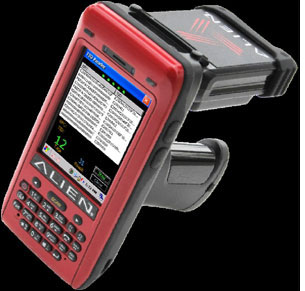Alien Technology is unveiling a passel of new products—an addition to its ultrahigh-frequency (UHF) Gen 2 integrated circuit family, a line of handheld readers, and four RFID inlays—at this week’s RFID Journal LIVE! 2011 conference, being held on Apr. 12-14, in Orlando, Fla.
The Higgs 4 integrated circuit is the newest member of Alien’s widely used Higgs family of RFID tag chips. The company has migrated much of the performance and functionality of the Higgs 3 model into the Higgs 4 IC—though with the Higgs 4, says Mike Frieswyk, Alien’s VP of sales and marketing, the company has made improvements to the chip’s RF-sensitivity and noise-interference capabilities, which he says will boost the reliability and performance of the RFID tags in which the chip is used. The major change in the Higgs 4 version is a decrease in the chip’s overall memory (512 bits in Higgs 4, versus 800 bits in Higgs3), and how that memory is allotted.
Whereas the Electronic Product Code (EPC) portion of the memory bank in a Higgs 3 chip (which Alien will continue to manufacture) can be configured from 96 bits up to 480 bits, the EPC field in a Higgs 4 chip is fixed at 128 bits. The Higgs 3 model has 512 bits of user memory, while Higgs 4 has 128 bits. (Like its predecessor, the Higgs 4 version stores a 64-bit unique tag ID, and sets aside 32 bits of memory for an access password and another 32 bits for a kill password.)
“We looked at how our customers were using the chip’s memory,” Frieswyk explains. “In 90 percent of the usage models, they weren’t using [all of] the user memory.” Reducing the user memory in the Higgs 4, he says, will make tags utilizing that chip more affordable than those using the Higgs 3 iteration, since memory equals cost. End users who want more than 128 bits of user memory can employ tags with Higgs 3 chips instead.
Alien intends to make samples of the Higgs 4 chip available in June 2011, with general availability scheduled for late September. The company, however, has yet to release pricing information.Alien has also announced its first-ever line of handheld readers. The ALH-9000 contains an RFID EPC Gen 2/ISO 18000-6C reader module, a 1-D bar-code scanner, a 3.5-inch color VGA touch screen, Microsoft‘s Windows CE NET 5.0 operating system, an 820 MHz processor and 128 megabytes of RAM. The ALH-9001 version includes a 2-D bar-code scanner, a 3-megapixel camera (with a built-in flash), Bluetooth functionality, a wireless high-speed downlink packet access (HSDPA) option with GPS (the ALH-9000 model uses 802.11b/g networking and has no GPS option) and a 4,000mAh lithium-ion battery (the ALH-9000 model uses a 3,000mAh battery).
“As [RFID applications] in apparel are taking off, we see handhelds as a big play in that market,” says Pat Ervin, Alien’s VP of global sales. “Plus, handhelds play a role in most item-level applications, whether in retail, or things like asset tracking in data centers.”
The ALH-9000 and ALH-9001 readers cost $3,295 and $3,995, respectively, and are expected to be made available in the United States and Europe in May of this year.
In addition, Alien has announced four new UHF EPC Gen 2 RFID inlays: the Squiglette (ALN-9630), H (ALN-9627), Squig (ALN-9610) and SIT (ALN-9613). The Squiglette, as its name infers, is a smaller version of Alien’s popular Squiggle tag (which measures 3.73 inches by 0.32 inch, whereas the Squiglette measures 2.75 inches by 0.37 inch) and is designed with item-level RFID tagging applications in mind, such as embedding the tag into apparel hangtags.
The Squig is also a smaller version of the Squiggle, but with a boxier antenna design. This inlay, which measures 1.75 inches by 0.41 inch, is targeted at item-level pharmaceutical tracking, or could also be employed in apparel hangtags. The H inlay does not share the other models’ squiggly antenna design, but instead uses two thick tabs joined by a single, curving connection (forming a design akin to an H). This inlay, measuring 1.18 inches by 1.77 inches, is also optimized for item-level tagging.The SIT inlay is unlike the others, in that it is extremely small—measuring 0.472 inch by 0.354 inch—but more importantly, it uses a near-field (that is, magnetic, or inductive, coupling) antenna design, so the inlay can be read only within up to 8 inches from a reader. The SIT inlay is thus designed for applications for which the tag’s footprint must be very small—for item-level tagging of jewelry or pharmaceutical vials, for instance—and for which the end user does not require or want long-range reading capability. Alien has offered this inlay before, but only through special orders. This is the first time the company is bringing this model to its main product line. The SIT is also the first such commercially available tag in production, according to the company. Impinj, another RFID hardware provider, does offer near-field antenna reference designs for inlays, as well as a tag chip that can accommodate both a near-field (loop) antenna and a far-field (dipole) antenna on the same inlay.
To operate in the near field, a UHF tag must have a loop antenna, as the SIT tag does. But any UHF passive tag can operate in the near field, as long as its antenna forms a loop, and as long as it is read with a loop antenna attached to an interrogator. The SIT tag is designed for near-field reading, and does not have a second tag antenna dedicated to far-field reading; however, the tag could be read in the far field if it were attached to a conductive product, such that the product could effectively function as a far-field tag, thereby allowing it and the reader to communicate with each other via backscatter coupling.
According to Alien Technology, all four new inlays are available now. The SIT tag will make its debut as part of an RFID-enabled beverage-dispensing system designed by ValidFill. The tag’s short read range enables the system to differentiate each tagged cup within a group of cups in close proximity to one another, while using magnetic coupling to read the tags helps deter RF interference from liquids and metal in the dispenser.
The new chip, reader and inlays are the first major releases since Alien Technology came under new leadership in November 2010, when Peter Green took the helm as CEO. Green says his aim is to infuse a new perspective to the company, since his background is steeped in semiconductors (his résumé includes stints at both Intel and Texas Instruments), rather than RFID, specifically. “I’m coming in with a fresh set of eyes,” he says. “This market is actually finally crossing that strategic inflection point to achieve great growth.” His vision, he adds, is to cater Alien’s products and services to particular vertical applications.
“There will be a slight change in how tags are designed, per application,” Green explains. “When I look at vertical applications, I think some require capabilities that are slightly different. That’s something we can use our design capability to respond to, both at silicon level and software level. You can’t do just one chip for everyone.”



